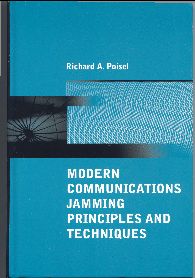
Modern Communications Jamming Principles and Techniques
R. A. Poisel
Artech House, 2004, 479 pages

|
 n his latest book, Dr. Poisel continues his in-depth description
of electronic warfare applied to modern communications technologies, specifically
direct-sequence spread-spectrum (DSSS) and ultrawideband communications. After
a thorough and fascinating introduction to signal propagation and the principles
of DSSS, jamming technologies, and signal detection, the book compares different
approaches to interfering with these digital communications. These methods include
old-fashioned broadband noise, partial-band noise, single- and multitone jamming,
pulsed jamming, and smart jamming. These more sophisticated technologies can be a
cat-and-mouse game as the senders adapt their encoding patterns to the new environment.
The signals are usually BPSK- or QPSK-modulated digital signals,
which are inherently more vulnerable than analog; but the processing gain afforded
by the bandwidth expansion makes them very difficult to intercept and expensive
to jam.
n his latest book, Dr. Poisel continues his in-depth description
of electronic warfare applied to modern communications technologies, specifically
direct-sequence spread-spectrum (DSSS) and ultrawideband communications. After
a thorough and fascinating introduction to signal propagation and the principles
of DSSS, jamming technologies, and signal detection, the book compares different
approaches to interfering with these digital communications. These methods include
old-fashioned broadband noise, partial-band noise, single- and multitone jamming,
pulsed jamming, and smart jamming. These more sophisticated technologies can be a
cat-and-mouse game as the senders adapt their encoding patterns to the new environment.
The signals are usually BPSK- or QPSK-modulated digital signals,
which are inherently more vulnerable than analog; but the processing gain afforded
by the bandwidth expansion makes them very difficult to intercept and expensive
to jam.
Ultrawideband signals are particularly resistant to interference because the signal is typically below the noise floor of the receiver, making it difficult to determine its presence. For fast frequency hopping (FFH) signals, in which the frequency is changed more than once for each bit, following the signal becomes even more difficult and the results of all the common forms of jamming are dismal indeed. This is illustrated in chapter 9 with graphs showing that narrowband noise and single-tone jamming, even at high jam/signal ratios, are almost completely ineffective against Golay-encoded FFH bitstreams.
The author also describes his simulations, which clearly show the benefits of using a forward detector (as opposed to a standoff configuration). The treatment is at a high level, with numerous graphs and big honking equations, some of which take up an entire page.
See also Introduction to Communication Electronic Warfare Systems.
